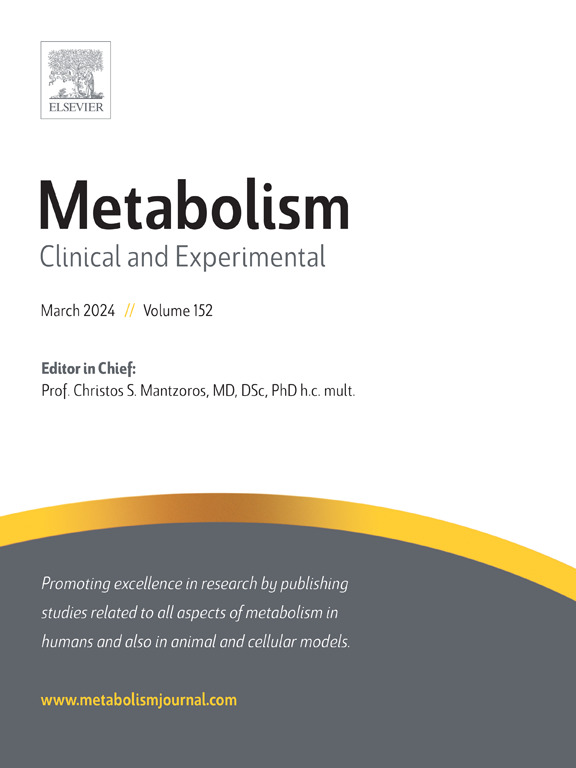2型糖尿病与肌肉质量、功能和虚弱的共同遗传结构揭示了共病病因和多效药物靶点。
IF 10.8
1区 医学
Q1 ENDOCRINOLOGY & METABOLISM
引用次数: 0
摘要
背景:描述具有肌肉量、功能和虚弱的2型糖尿病的共同遗传结构对于揭示共同病因和制定针对这些共存疾病的整体治疗策略至关重要。方法:在这项全基因组多效性关联研究中,我们使用多达461,026名欧洲血统个体的全基因组关联研究汇总统计数据进行了多效性性状的多效性分析,以剖析2型糖尿病和7种血糖性状与4种肌肉质量和功能相关表型以及脆弱指数的共同遗传因素和因果关系。结果:通过连锁不平衡评分回归和高清晰度似然分析,首次鉴定出27对具有显著遗传相关性的亲本。通过复合零假设多效性分析(PLACO)、共定位和基因组注释多标记分析(MAGMA)分析,确定了79个多效性位点和109个多效性基因。随后,我们使用关节组织植入进行了转录组全关联研究(TWAS)分析,并通过条件TWAS方法通过基于基因的整合精细定位进行了改进,确定了13个组织中44个独特的因果共享基因,包括8个可药物基因(ABO、AOC1、FTO、GCKR、MTOR、POLK、PPARG和APFH),其中MTOR和PPARG被归类为临床可操作基因。双样本孟德尔随机化分析支持糖尿病与虚弱指数之间的双向因果关系以及肌肉表型对血糖谱的单向因果关系。结论:我们的研究结果强调了2型糖尿病与肌肉损失和虚弱之间的共同遗传基础,并为针对这两种衰老相关挑战具有多效性作用的药物靶点提供了信息。本文章由计算机程序翻译,如有差异,请以英文原文为准。

Shared genetic architecture of type 2 diabetes with muscle mass and function and frailty reveals comorbidity etiology and pleiotropic druggable targets
Background
Delineating the shared genetic architecture of type 2 diabetes with muscle mass and function and frailty is essential for unraveling the common etiology and developing holistic therapeutic strategies for these co-existing conditions.
Methods
In this genome-wide pleiotropic association study, we performed multi-level pairwise trait pleiotropic analyses using genome-wide association study summary statistics from up to 461,026 European ancestry individuals to dissect the shared genetic factors and causal relationships of type 2 diabetes and seven glycemic traits with four muscle mass- and function-related phenotypes and the frailty index.
Results
We first identified 27 pairs with significant genetic correlations through the linkage disequilibrium score regression and high-definition likelihood analysis. Then we determined 79 pleiotropic loci and 109 pleiotropic genes across linkage pairs via the pleiotropic analysis under the composite null hypothesis (PLACO), the colocalization, and the Multi-marker Analysis of GenoMic Annotation (MAGMA) analyses. We subsequently performed transcriptome-wide association study (TWAS) analyses using joint-tissue imputation, refined by gene-based integrative fine-mapping through a conditional TWAS approach, and identified 44 unique causal shared genes across 13 tissues in linkage pairs, including eight druggable genes (ABO, AOC1, FTO, GCKR, MTOR, POLK, PPARG, and APEH), with MTOR and PPARG categorized as clinically actionable. Two-sample Mendelian randomization analysis supported bidirectional causality between diabetes and frailty index and unidirectional causal effects of muscle phenotypes on glycemic profiles.
Conclusions
Our findings highlight the common genetic underpinnings between type 2 diabetes and muscle loss and frailty and inform drug targets with pleiotropic effects on both of these aging-related challenges.
求助全文
通过发布文献求助,成功后即可免费获取论文全文。
去求助
来源期刊

Metabolism: clinical and experimental
医学-内分泌学与代谢
CiteScore
18.90
自引率
3.10%
发文量
310
审稿时长
16 days
期刊介绍:
Metabolism upholds research excellence by disseminating high-quality original research, reviews, editorials, and commentaries covering all facets of human metabolism.
Consideration for publication in Metabolism extends to studies in humans, animal, and cellular models, with a particular emphasis on work demonstrating strong translational potential.
The journal addresses a range of topics, including:
- Energy Expenditure and Obesity
- Metabolic Syndrome, Prediabetes, and Diabetes
- Nutrition, Exercise, and the Environment
- Genetics and Genomics, Proteomics, and Metabolomics
- Carbohydrate, Lipid, and Protein Metabolism
- Endocrinology and Hypertension
- Mineral and Bone Metabolism
- Cardiovascular Diseases and Malignancies
- Inflammation in metabolism and immunometabolism
 求助内容:
求助内容: 应助结果提醒方式:
应助结果提醒方式:


